AMD Announces Carrizo and Carrizo-L, Next Gen APUs for H1 2015
by Ian Cutress on November 20, 2014 5:45 PM EST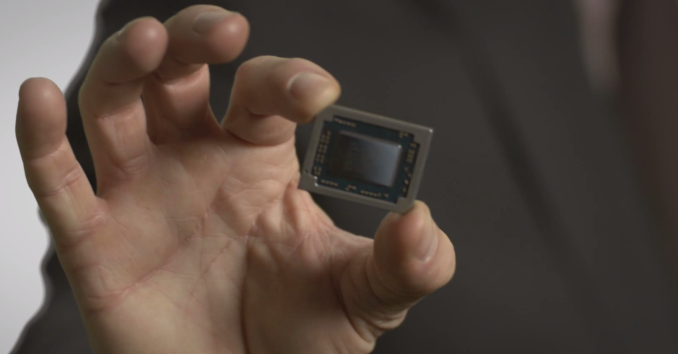
Today AMD is announcing the long anticipated upgrade to Kaveri, codenamed Carrizo. Carrizo is the natural successor to Kaveri, featuring x86 ‘Excavator’ cores alongside a Radeon-class GPU and promising an increase in performance all around. The second part of today’s announcement is for Carrizo-L, an SoC pairing “Puma+” (upgraded Beema) cores also with AMD’s R-series GCN GPUs and a FCH into a single package. Both Carrizo and Carrizo-L will feature ARM Trustzone, giving potential hardware-based built-in security when used by developers.
The Excavator cores are an architectural improvement over Steamroller, but are fundamentally based on the original Bulldozer concept. Excavator will be AMD’s fourth iteration of the concept, following Bulldozer, Piledriver and Steamroller. This new generation of APUs are still set to be built on the 28nm Super High Performance process at Global Foundries, delaying AMD’s shift to 20nm, but AMD are still claiming that the new GPU in Carrizo is their best yet, giving better performance and efficiency than before.
Given AMD's discrete GPU lineup, the GPU for Carrizo could be based on AMD's latest GCN 1.2 architecture, which was first introduced in the desktop Tonga part earlier this year. GCN 1.2's lossless delta color compression algorithms help improve the performance in memory bandwidth limited scenarios, such as in APUs. This could result in a bigger-than-expected jump in performance, although we will wait until we can test to find out how much it helps.
The Carrizo platform will be fully HSA 1.0 compliant, compared to Kaveri which only had ‘HSA Features’, as AMD puts it in their latest mobility roadmap update:
The push from AMD into HSA compliant APUs was well documented back at the launch of Kaveri earlier this year. This enabled the CPU and GPU components of the silicon, while under OpenCL 2.0 mode, to have access to the main block of system DRAM with zero-time copy functions, offering the potential for large classes of applications especially those in the prosumer and industry space to be accelerated by having instant access to the parallelization afforded by the GCN GPU. One of the big drawbacks of being an earlier adopter to HSA, as we noted at the time, was that software developers required time to bring their code to market, as well as AMD having to go out and teach the developers how to cater for HSA topology.
Both Carrizo and Carrizo-L on the mobile side will be targeted at the same power bands as Kaveri and Beema, although the socket will be new. The use of FP4 BGA also indicates that a single socket will cater for both the Excavator and Puma+ based APUs and would be interchangeable. A video by AMD’s VP/GM for Computing and Graphics, John Byrne, states that Carrizo and Carrizo-L are currently being tested internally ready for a 1H 2015 release, along with support for DirectX 12, OpenCL 2.0, Mantle and Freesync.
One of the big features that AMD is pushing with Carrizo is energy efficiency, with it being a keystone of the message. Because AMD have been on the same process node for a short while, they have to essentially follow the Maxwell example, by providing more performance for less power without the advantage of shrinking resistors. We were provided with an energy efficiency roadmap as well, showing the different methods AMD is using to achieve this:
One example of the efficiency improvement was provided by AMD’s Voltage Adaptive Operation. Rather than compensate for voltage variations which wastes energy, this technology takes the average operating voltage and detects when the voltage increases beyond a smaller margin. To compensate for this increase, the CPU speed is reduced until the voltage drops below the threshold and then the CPU speed is moved back up.
The changes in speed are designed to be so minute that it does not affect overall performance, however it might only take an errant voltage delivery component to consistently make the voltage go above that threshold, causing erratic slowdown that might be statistically significant. It will be interesting to see how AMD implements the latest version of this feature.
The 2015 desktop roadmap remains unpublished so far. AMD’s perception of a mobile-focused strategy would tend to suggest that the mobile comes first, with desktop following behind, although at this point it is unclear. A number of AMD’s marketing materials with this launch gave examples of the use of Carrizo and HSA for the prosumer, indicating that a desktop version should be announced in due course.
As of yet there was no discussion on the APUs to be launched, the speeds or the capabilities. All the roadmap tells us is 'up to four cores' (Excavator for Carrizo, Puma+ for Carrizo-L), some GCN compute units and 10-45W overall. There is no mention of DDR4 support, although the timeframe might be relevant for AMD to make the jump. Given the launch is still at least two quarters away, I would expect better details in due course. That timeframe fits in nicely around or just after Computex, perhaps indicating more details then.
Source: AMD


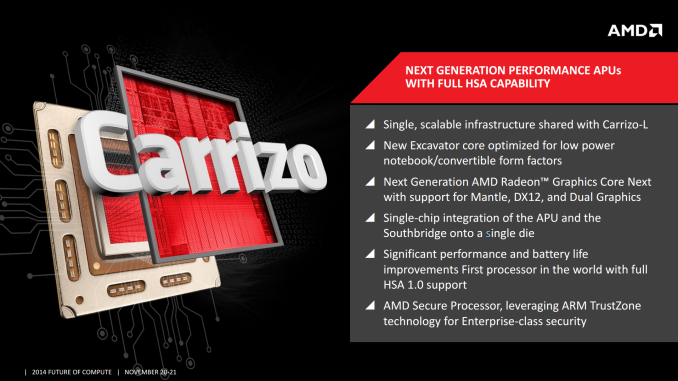
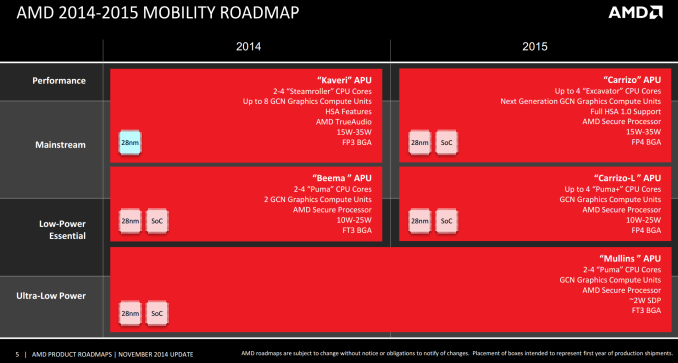
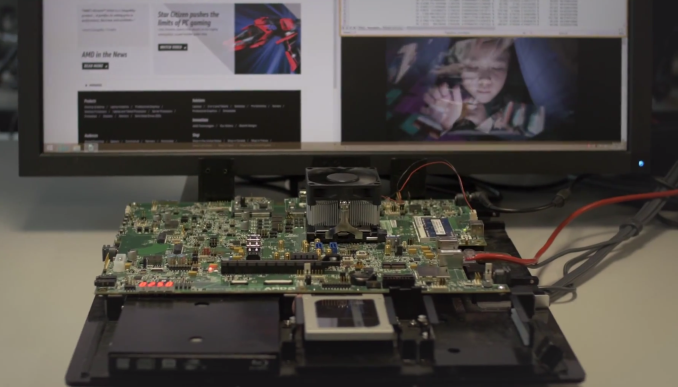
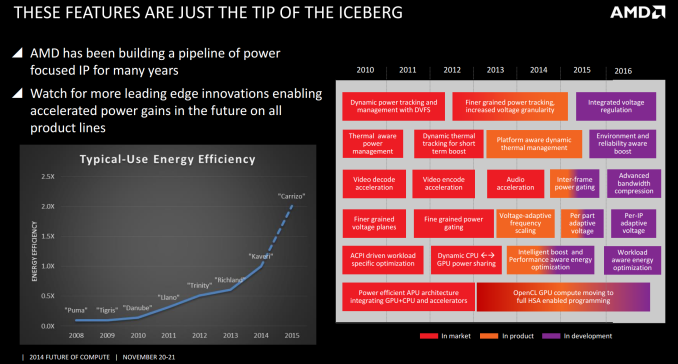
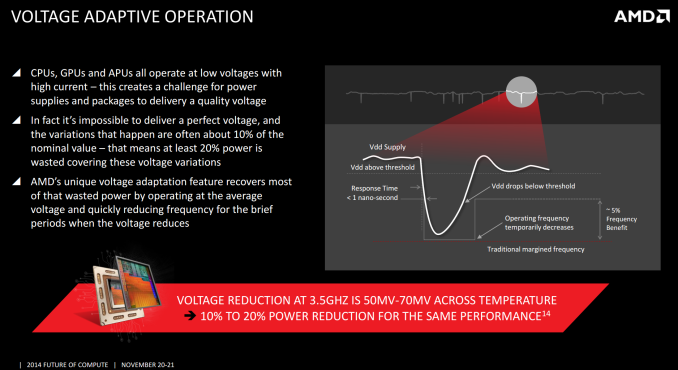
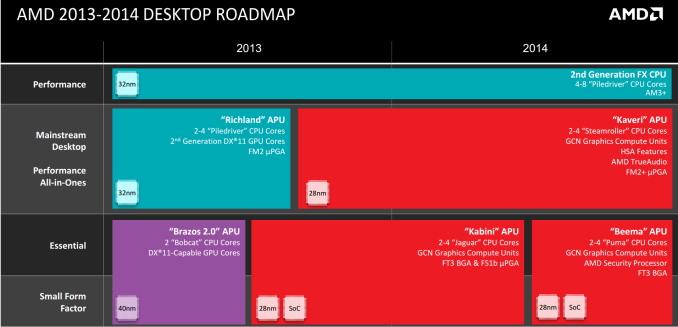








94 Comments
View All Comments
nt300 - Wednesday, January 7, 2015 - link
AMD did have the opportunity to claw back some performance ground. Intel has been sleeping at the helm with terrible yields. That said, Intel is well known for "Anit-Competitive" practices. They were also charged and had to pay AMD for damages. They paid up more than once.http://www.theverge.com/2014/6/12/5803442/intel-ne...
Acreo Aeneas - Sunday, November 23, 2014 - link
You keep mentioning 1080p. For games or video? If for video, then current and pay APUs can already do that on AMD's side. For games, that's not feasible given the price point and power envelopes that APUs are aimed at.Acreo Aeneas - Sunday, November 23, 2014 - link
Pay should be older. Autocorrect follies.mrdude - Sunday, November 23, 2014 - link
nVidia's Maxwell 750Ti drives 1080p at high really well and it does that at sub-75W TDPs. Bear in mind that's for the full GPU, including the PCB, vRAM, etc. If on a single die, redundancies would be eliminated and realistic TDP would be quite a bit lower.AMD producing an APU that can do the same is certainly possible if not for a few bottlenecks: 1 - Their CPU architecture is inefficient. A new uArch isn't coming until 2016, and I don't expect any significant improvements until then 2 - Their current GPU architecture is lackluster in perf-per-watt, but that should (hopefully) change. 3 - AMD still hasn't managed to alleviate the memory bottleneck. Adding any sort of GPU power to an APU is fruitless until that is completely addressed.
To clarify, I wasn't mentioning video. You can buy an ARM SoC for a few bucks that can drive 1080p video just fine. 1080p video should be a given at this point.
Redwoodz - Sunday, December 7, 2014 - link
Well,if Intel can"t make a APU that runs 1080p on high why would you expect AMD to at this point? Fact is they can make one,but not at the cost needed.Furthermore,gamers that want to run all games on Ultra settings on 1080p are going to buy a dedicated GPU,not an APU.patrickjp93 - Friday, December 19, 2014 - link
Intel can now that it has a few years of graphics engineering under its belt. Broadwell is increasing throughput per core by 40% while also including 20% more cores. Intel didn't care about gaming ever. It's been aiming at increasing compute power to maintain absolute dominance over IBM and Sun for supercomputer CPUs in the future and encourage even more OEMs to switch. Beyond that, Intel has finally looked at knocking Nvidia clean out of the mobile GPU market, and AMD is waking up a bit more in laptop integrated graphics.The main problem with Iris Pro 5200 is 10 EUs (cores) per sub-slice (a group connected by a data bus). That created a big throughput bottleneck where the bus couldn't keep the cores fed. With that knocked out, we can see Intel start to cook, especially if they create a good tessellation engine.
Even though AMD's quad-core processors have 800 million more transistors and 2.x million per transistors per sq. mm, Intel still has the performance crown. If you think Intel won't make an APU by the end of 2016 capable of doing 1080p high/ultra at 50+ fps, you're naive as IBM was to say Intel would never compete in the server world. Look at how that turned out for IBM. All they have left are mainframes for banks.
nt300 - Wednesday, January 7, 2015 - link
At the time, AMD went through a complete management overhaul. Hopefully all gets rectified in 2015. And yes I have no problems driving 1080p on MAX Settings with my Kaveri APU.domboy - Friday, November 21, 2014 - link
Agreed! I'd really like to see something like the Asus T100 with an AMD APU in it.Morawka - Friday, November 21, 2014 - link
well we are comparing them to core because the last Kavari chips were priced like Core. I think $155 is the cheapest unit, most of the 384 and 512 Shader Sku's were $180+. Same price as a lastest and greatest Core i5.samlebon2306 - Friday, November 21, 2014 - link
AMD A10 7850K 4.0 GHz Black Edition Boxed processor for $109 at Micro Center:http://www.microcenter.com/product/427565/A10_7850...